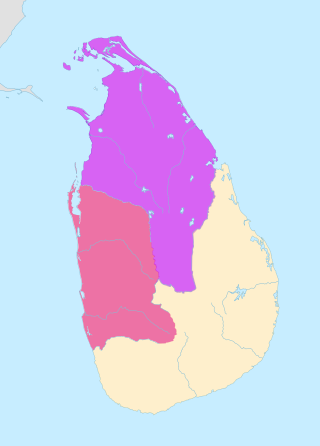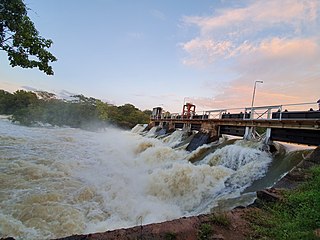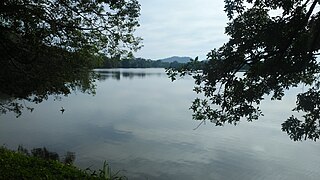
Poḷonnaruwa, also referred as Pulathisipura and Vijayarajapura in ancient times, is the main town of Polonnaruwa District in North Central Province, Sri Lanka. The modern town of Polonnaruwa is also known as New Town, and the other part of Polonnaruwa remains as the royal ancient city of the Kingdom of Polonnaruwa.

Kurunegala is a major city in Sri Lanka. It is the capital city of the North Western Province and the Kurunegala District. Kurunegala was an ancient royal capital for 50 years, from the end of the 13th century to the start of the 14th century. It is at the junction of several main roads linking to other important parts of the country. It is about 94 kilometres (58 mi) from Colombo, 42 kilometres (26 mi) from Kandy and 51 kilometres (32 mi) from Matale.
The ancient Sri Lankan people, which consisted of Sinhalese and Sri Lankan Tamils excelled in the construction of tanks (Wevas) or reservoirs, dagobas, Hindu temples and palaces in Sri Lanka, as evident from the ruins which displays a rich variety of architectural forms.

Parākramabāhu I, or Parakramabahu the Great, was the king of Polonnaruwa from 1153 to 1186. He oversaw the expansion and beautification of his capital, constructed extensive irrigation systems, reorganised the country's army, reformed Buddhist practices, encouraged the arts and undertook military campaigns in South India and Burma. The adage "Not even a drop of water that comes from the rain must flow into the ocean without being made useful to man" is one of his most famous utterances.

Wasgamuwa National Park is a natural park in Sri Lanka situated in the Matale and Polonnaruwa Districts. It was declared to protect and to make a refuge for the displaced wild animals during the Mahaweli Development Project in 1984 and is one of the four National Parks designated under the Project. Originally it was designated as a nature reserve in 1938, and then in the early 1970s the area was regraded as a strict nature reserve. Wasgamuwa is one of the protected areas where Sri Lankan Elephants can be seen in large herds. It is also one of the Important Bird Areas in Sri Lanka. The name of the Wasgamuwa has derived from the words "Walas Gamuwa". "Walasa" is Sinhala for sloth bear and "Gamuwa" means a wood. The park is situated 225 km away from Colombo.

The Kingdom of Polonnaruwa was the Sinhalese kingdom that expanded across the island of Sri Lanka and several overseas territories, from 1070 until 1232. The kingdom started expanding its overseas authority during the reign of Parakramabahu the Great.
Minneriya is a small town in Sri Lanka that is famous for two things — the great Minneriya lake built by King Mahasen and Minneriya National Park which is a hot spot for safari lovers because of its abundance of elephants. Furthermore, it is near the tourist-friendly Habarana and the world heritage sites Anuradhapura, Polonnaruwa and Sigiriya.

Kala Wewa built by the King Datusena in 460 A.D, is a twin reservoir complex which has a capacity of 123 million cubic meters. This reservoir complex has facilitated with a stone made spillway and three main sluices. From the central major sluice, a 40 feet wide central conveys water to feed thousands of acres of paddy lands and ends at the historical capital Anuradhapura city tank Tissa Wewa meandering over 87 km (54 mi) at a slope of 6 inches per mile and is another wonder of primeval hydraulic engineering facility in ancient Ceylon.

The irrigation works in ancient Sri Lanka, the earliest dating from about 300 BCE, in the reign of King Pandukabhaya and under continuous development for the next thousand years, were some of the most complex irrigation systems of the ancient world. In addition to constructing underground canals, the Sinhalese were among the first to build completely artificial reservoirs to store water. The system was extensively restored and further extended during the reign of King Parākramabāhu.
Angammedilla National Park is one of the new national parks in Sri Lanka. The region was designated national park on 6 June 2006. Originally Angammedilla was a forest reserve within the Minneriya-Girithale Sanctuary declared on 12 February 1988. The park is declared mainly to protect the drainage basin of Parakrama Samudra. Angammedilla also secures the drainage basins of Minneriya and Girithale irrigation tanks, water sources in Sudu Kanda and habitats and wildlife of the adjacent forests. It is located 225 kilometres (140 mi) away from Colombo in Polonnaruwa District.

Statue of Parakramabahu I, located near the Pothgul Vehera in Polonnaruwa is a stone sculpture dating back to the Polonnaruwa period of ancient Sri Lanka. Its identity is uncertain, although the widely accepted theory is that it is a statue of Parakramabahu I. However, it has also been suggested as the statue of a sage. Carved on a large boulder, the statue depicts a majestic figure with a grave expression, holding a book or yoke in his hands.
Thamankaduwa Divisional Secretariat is a Divisional Secretariat of Polonnaruwa District, of North Central Province, Sri Lanka. It contains Parakrama Samudra and the historic ruins of the Polonnaruwa period.
Parakrama Pandyan II, also Pandu Parakramabahu of Polonnaruwa or Parakrama Pandu, was a Pandyan king who invaded the Kingdom of Polonnaruwa in the thirteenth century and ruled from 1212 to 1215 CE. His namesake royal Parakrama Pandyan I had ruled in Madurai fifty years earlier and had sought help from his contemporary Parakramabahu I of Polonnaruwa when faced with a Pandyan civil war. Parakrama Pandyan II came to the throne deposing Lilavati—ruling monarch, consort and successor of Parakramabahu I—as king of Polonnaruwa. He ruled for three years until Polonnaruwa was invaded and he was taken captive by Kalinga Magha, who succeeded him.

Abhaya Wewa, historically Abhayavapi or Bassawakkulama reservoir, is a reservoir in Sri Lanka, built by King Pandukabhaya who ruled in Anuradhapura from 437 BC to 367 BC, after constructing the city.

The Pandyan Civil War from 1166 to 1182 was precipitated by rival claims of succession to the Pandyan throne. The Civil War began between Parakrama Pandyan and his nephew Kulasekhara Pandyan and lasted for next 15 years between successive Pandyan kings. The war gradually spread to the rest of Southern India when the Chola King Rajadhiraja II and the Sinhalese King Parakramabahu I of Polonnaruwa entered the fray and took opposing sides in the conflict, eager to increase their influence in the Pandya kingdom.

Rajarata [rā dja ra tə] was one of three historical regions of the island of Sri Lanka for about 1,700 years from the 6th century BCE to the early 13th century CE. Several ancient cities, including Tambapanni, Upatissa Nuwara, Anuradhapura and Polonnaruwa, were established as capitals within the area by successive rulers. Rajarata was under the direct administration of the King. Two other areas, Malayarata and Ruhunurata, were ruled by the king's brothers "Mapa" and "Epa". The Magha invasion in the 13th century brought about the end of the Rajarata kingdom.

Tissa Wewa, an artificial reservoir, was built by Devanampiya Tissa in order to increase the water supply to his capital city of Anuradhapura. Only Panda Wewa and Abhaya Wewa are older. The embankment of Tissa Wewa is 2 miles (3.2 km) long and 25 feet (7.6 m) high.

Nachchaduwa wewa is a reservoir near Thammannakulama, Sri Lanka. The reservoir is used to store water brings from Kala Wewa through Yoda Ela channel. The reservoir was severely damaged in 1957 flood and the restoration of the tank was completed in 1958.

Sorabora Wewa is an ancient reservoir in Mahiyangana, Badulla District Sri Lanka. It is thought to have been constructed during the reign of King Dutugemunu by a giant named Bulatha. In the ancient past, this tank was known as the 'Sea of Bintenna'.

The tank cascade system, or wewa-ellangava system, is an ancient Sri Lankan irrigation infrastructure. The system is a network of small tanks draining to large reservoirs that store rainwater and surface runoff for later use. Originating in the 1st millennium BCE, the system was designated a Globally Important Agricultural Heritage System by the United Nations Food and Agriculture Organization in 2017. Centralized bureaucratic management of large-scale systems was implemented from the 3rd to the 13th centuries.















